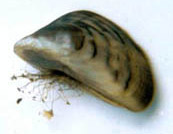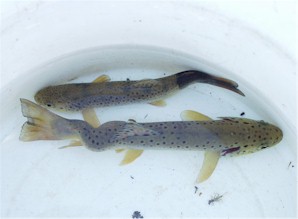Crayfish Transportation Prohibited
 To prevent the spread of rusty crayfish, an aggressive invasive species, Colorado Parks and Wildlife has orders preventing the removal of any live crayfish from Sanchez Reservoir State Wildlife Area. For waters west of the Continental Divide, fishermen and women either have to return crayfish immediately to the water of origin or kill immediately upon catch, take into possession, and separate the tail from the abdomen.
To prevent the spread of rusty crayfish, an aggressive invasive species, Colorado Parks and Wildlife has orders preventing the removal of any live crayfish from Sanchez Reservoir State Wildlife Area. For waters west of the Continental Divide, fishermen and women either have to return crayfish immediately to the water of origin or kill immediately upon catch, take into possession, and separate the tail from the abdomen.
Please the rusty crayfish species profile for more information.
Mandatory Boat Inspections
All out-of-state boats and resident boats that go out-of-state and return to Colorado must pass a state-certified inspection for zebra mussels and other aquatic nuisance species prior to launching in any Colorado lake, reservoir or waterway. In addition, boats that have launched on any of the Colorado lakes or reservoirs where mussels have been detected must pass an inspection before launching at a new location. See the Mandatory Boat Inspections page for complete details.
 Zebra and quagga mussels are small, non-native barnacle-like mollusks with dark and light colored stripes. They damage equipment by attaching to boat motors or hard surfaces and clog water treatment facilities.
Zebra and quagga mussels are small, non-native barnacle-like mollusks with dark and light colored stripes. They damage equipment by attaching to boat motors or hard surfaces and clog water treatment facilities.
Public awareness and participation is the best weapon in the containment of invasive species. Boaters are reminded to take the simple precaution of making sure that they Clean, Drain and Dry their boat when they leave the lake.
Help Stop the Spread of Whirling Disease
 The Colorado Parks and Wildlife has regulations that control the stocking by state and private hatcheries of fish exposed to whirling disease. It is important to have the cooperation of anglers in preventing the spread of this disease. Precautionary measures include:
The Colorado Parks and Wildlife has regulations that control the stocking by state and private hatcheries of fish exposed to whirling disease. It is important to have the cooperation of anglers in preventing the spread of this disease. Precautionary measures include:
Clean your boots, waders and other gear before moving from one fishing site to another, and again with chlorine when you get home if you fished at a known whirling disease water;
Clean your boat and trailer of mud, aquatic plants and water before fishing new waters;
If fishing many sections of a stream, start at the higher elevations;
Don’t dispose of fish entrails, bones or other parts in or near any body of water or down kitchen drains;
Dispose of fish parts as solid waste; and
Never transport fish from one water to another.
For more information, see the Whirling Disease page.
Trip Planning Resources
The Colorado Fishing Atlas: The latest interactive mapping tool offered by Colorado Parks and Wildlife allows users to search for fishing opportunities by species, specific interest or proximity to your home or destination. Spend a few minutes viewing a series of short video tutorials to learn about all the great new features or jump right in and start scouting from the comfort of your home today.
Road/Land closures: Check for closures in the area you plan to fish. This information, from the BLM and USDAFS, changes often so go to their Web sites for current closures: BLM for Colorado, US Forest Service (you'll need to know in which forest you will be hunting).
Forest Safety: Forest Service officials want to remind you to watch out for falling trees, especially in areas affected by the 2.5 million acre mountain pine beetle epidemic. Check out the US Forest Service website for more information on guidelines, safety tips and Bark Beetles.
Hotel accommodations and activities in your fishing area.
Camping? See the Colorado State Parks general camping rules. Fishing in a Colorado State Park? The individual Parks also have important fishing information. The USDA Forest Service website also provides camping information for Forest Service lands.
If you’ll be camping during your fishing trip, please help protect our forests by buying your firewood in Colorado. Firewood can spread harmful insect pests and diseases such as emerald ash borer, sirex wood wasp, gypsy moth, Asian longhorned beetle, and oak wilt disease. If you have brought firewood from another state, please burn it immediately. For more information contact the Colorado Department of Agriculture at 303/239-4140.
Firebans: A link to the Colorado Division of Emergency Management fire bans and restrictions information.
A current Colorado Off-Highway Vehicle (OHV) registration or permit is required for all OHVs that are operated on public lands. See the OHV Registrations, permits and full program details.
Motor Vehicle Use Maps from the U.S. Forest Service. Go to the Travel Management & Off-Highway Vehicle Program website; click the link under "Motor Vehicle Use Maps"; select a Colorado forest. The USFS advises that new forest and district maps will be added by October 1, so check back!
Planning to bring a more 'basic' mode of transportation? Horse? Mule? You must contact a veterinarian to get a Certificate of Health Inspection within 30 days before horses enter Colorado. Horses also need a Coggins Blood Test for equine infectious anemia within a year before coming here. For details and procedures, call the Colorado State Veterinarian’s office, 303/239-4161. See also the Animal Movement Requirements.
Please do not bring forage for your stock to Colorado that has not been certified as weed-free. The Colorado Department of Agriculture's Weed-Free Forage Program maintains a database of approved sources for weed-free forage, listed either by producer or location. Learn about the consequences of using non-certified forage; go the the CPW's Weed-Free Forage Program page.

